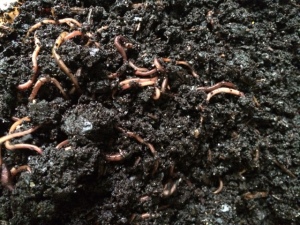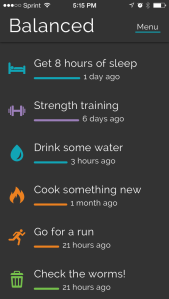Those that have witnessed one of my CBSM presentations (or read last week’s post) have heard my sustainable behavior change failure story (Failure stories are fun, right? Read mine here.)
But this post isn’t about my failure…it’s about my recent SUCCESS!
Four months ago, I started a new job. This new job meant a longer commute (15-45 minutes longer each way), and longer hours (an extra hour 4 days a week to allow one day off every other week). But it also meant I’d be surrounded by sustainably-minded colleagues again, and I was looking forward to the challenges and opportunities of the new position. So, on one hand, I had greater limitations on my time and energy, but on the other hand, I could start with a clean slate and perhaps have the support of my new work environment.
What’s the result? Two distinct changes that demonstrate the behaviors many of us strive for in our own lives, or to promote in others’.
-

The worm bin!
I’ve been successfully maintaining a healthy and thriving vermiculture compost for the last 4 months. Barriers? …See my failure story.
- I’ve been exercising regularly and adopted other healthy habits for the last 4.5 months. Barrier #1: I decided morning was the most fool-proof plan to integrate physical activity into my schedule. But getting up at 6am is a whole 1.5 hours earlier than I typically was getting up…”Uff da”! Barrier #2: I hated running…and really exercise in general.
If my story of failure demonstrated the challenge of behavior change, I hope my success story can begin to uncover the multiple and layered factors that make up a new behavior and habit. (Hint: Note the theme of community and social support throughout these factors…)
Change #1: Composting with Worms!
- Clean Slate (new job) Composting perhaps seemed like an appropriate way to celebrate the new job and commemorate a return to sustainability, plus summer was upon us in June – a good time to turn a new leaf
- Cognitive Dissonance (aligning identities) I felt like I had abandoned my sustainable self back at CERTs where I felt the gentle and positive pressure to put forth a little bit more effort to be a bit more gentle on the earth. Further, I was getting tired of telling my failure story over and over for the last several years. In my new work place, the Dept of Environmental Protection, I felt it was time to invite my earth-friendly values to manifest.
-
Infrastructure (patio) We finally had a patio and we made plans to stay in this apartment for awhile.
- Social Norm (descriptive) At my new job, I met a colleague whocomposts at home. Iwas referred to her, she beingsomeone that “walks the talk” and Susanne gave me great composting advice and confirmed for me that this is something my new colleagues do and support.In July, my worms arrived and the rest is history. I’m pretty sure I’ve doubled my worm population and am now looking for solutions to insulate them from the cold this winter!


Change #2: Exercising and other healthy stuff!
This one baffles me. Why would I decide to add exercise to my routine when my commute time is doubling and I’m working longer days? Plus, I had this aversion to sweating and running…
- Social Diffusion (example of a colleague) I thought of my friend and colleague who juggled a family, managed a rapidly growing nonprofit, and yet her morning run was (or seemed to be) one of the most consistent parts of her life. I’ve looked to her as a mentor for many things, and her running routine wasn’t lost on me.
- Clean Slate (new job and routine) Despite the new time costs of the new job, at the beginning of the summer, I was excited, refreshed, and had the morning sun to my advantage. I think I was also cognizant of the new responsibilities of the job and felt exercise would be an important part of me being able to handle it. HBR talks about how exercise is an important part one’s mental and emotional (and of course, physical health)…and self-care is an important aspect of a leadership practice.
-

Post-run stretching spot
Self-Perception (changed by action) …since my work colleagues never knew the me-that-didn’t-exercise, all they know is me with my new habit. This has done a number on my self-perception: my physical activity is a big part of who I consider myself to be now.
- Convenience (trail out back, good weather) I’ve got a beautiful trail in my backyard for running (I can see it from my patio) – it skips over beautiful creeks, I witness fox and deer on a regular basis, and this summer wasn’t so painfully hot and humid as the previous ones. On that same token, my gym is near work, and when I go to the gym early, I beat traffic and save 15 minutes or so off my commute.
 Prompts (reminders) For my other health-oriented habits, like drinking more water, getting enough fruit, and heading to bed on time, I knew that these wouldn’t take much time at all, but I needed to do them throughout the day – not all at once. I’m using an app called Balanced, which provides a nice reminder based on frequency (not time of day) to have that glass of water, get up and take a walk, be grateful, water my plants, and get 8+ hours of sleep most nights.
Prompts (reminders) For my other health-oriented habits, like drinking more water, getting enough fruit, and heading to bed on time, I knew that these wouldn’t take much time at all, but I needed to do them throughout the day – not all at once. I’m using an app called Balanced, which provides a nice reminder based on frequency (not time of day) to have that glass of water, get up and take a walk, be grateful, water my plants, and get 8+ hours of sleep most nights.
For both behaviors, ACCOUNTABILITY by COMMUNITY played a significant role. My community – as an example, as a support, and as a positive reward – plays a central role. At work, I have found a community that supports and congratulates a composting habit, among other sustainable practices. My partner at home, trainer at the gym, and yoga instructors and fellow yogis provide a supportive community for my new healthy habits. Community can be the tipping point: A friend, who has really picked up running, said that she had tried to “be a runner” for the last 10 years, and finally felt like she was one now that she was doing Team in Training and has a community to run with.
For all the research studies and linear processes of community-based social marketing, it is important to remember that behind the “social norms” and other tools, it is community that is truly still the most potent lever and key to persistent change. Actions not supported by a community will not last.
Build a community that (at least looks like it) supports a certain behavior, and we can begin to unlock that composter, energy conservationist, garden grower, yogi or runner in each of us!







